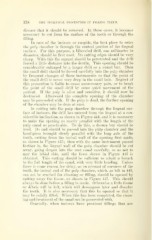Page 732 - My FlipBook
P. 732
378 THE TECHNICAL PROCEDURES IN FILLING TEETH.
disease that it should be removed. In these cases, it becomes
necessary to cut from the surface of the tooth or through the
filling.
In case of the incisors or cuspids, the best place to enter
the pulp chamber is through the central portion of the lingual
surface. For this purpose, a bibeveled drill, one millimeter in
diameter, should be first used. Its cutting edges should be very
sharp. With this the enamel should be penetrated and the drill
forced a little distance into the dentin. This opening should be
considerably enlarged by a larger drill or a round bur. Then
the small drill should be forced carefully into the pulp chamber
by frequent changes of these instruments so that the point of
the small drill is never very deep in the small hole. Neglect of
this precaution is liable to cause unnecessary pain, or to break
the point of the small drill by some quick movement of the
patient. If the pulp is alive and sensitive, it should now be
destroyed. Afterward the complete opening of the chamber
may be proceeded with. If the pulp is dead, the further opening
of the chamber may be done at once.
In cutting into the pulp chamber through the lingual sur-
face of incisors, the drill has entered from the lingual at a con-
siderable inclination, as shown in Figure 444, and it is necessary
to make the opening as nearly parallel with the length of the
pulp canal as ])racticable. To do this, a fissure bur should be
used. Its end should be passed into the pulp chamber and the
hand-piece brought slowly parallel with the long axis of the
tooth, cutting from the ineisal wall of the opening first made,
as shown in Figure 445 ; then with the same instrument passed
farther in, the lingual wall of the pulp chamber should be cut
away, going deeper into the root canal carefully, so as not to
mar the labial side, until the form shown in Figure 446 is
obtained. This cutting should be sufficient to admit a broach
to the full length of the canal, with very little bending. Unless
there is some reason for delay, as on account of soreness of the
tooth, the ineisal end of the pulp chamber, which, as left in 446,
can not be reached for cleaning or filling, should be opened by
cutting away the tissue, as shown in Figure 447. Tliis should
always be done before a filling is made. Otherwise a little tissue
or debris will be left, which will decompose later and discolor
the tooth. It is also necessary that this be opened so that it
may be solidly filled. Wlien this has been completed, the clean-
ing and ti'eatmont of the canal can be proceeded with.
Generally, when incisors have proximal fillings that are


